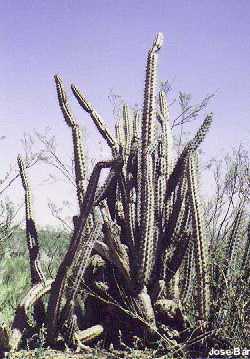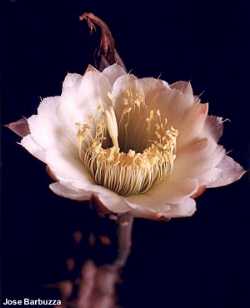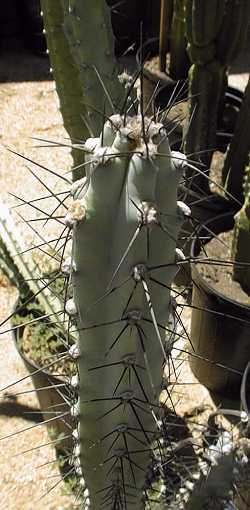USDA: 9b-11
Sun Exposure: Full sun
Origin: Brazil, Uruguay, and northern Argentina
Growth Habits: Succulent shrub, up to 7 feet tall (2 m), 5 feet spread (1.5 m); the bluish stems are 3 inches in diameter (7.5 cm); 5-8 ribs; areoles 0.6 inches apart (1.5 cm); 2-4 central spines, up to 0.8 inches long (2 cm); 7-12 radials, 0.4 inches long (1 cm).
Watering Needs: Little water, humus rich, well drained sandy soil
Propagation: Seeds in spring, or cuttings in summer

Copyright Jose Barbuzza
The Cereus aethiops forms clumps of blue green stems. They have 6 to 8 ribs. The areoles are 0.5 inch apart (1 to 1.5 cm), with 2 to 4 black central spines and a dozen of radial spines.
Cereus beysiegelii seems to be a cristate form (Borg 1945).
The clones with the thicker stems and 5-6 ribs have been described as Cereus chalybaeus while Cereus aethiops was described with 8 ribs and stems 1.5 inches in diameter (4 cm)
Picture 2 and 3 are from Willy Smith's Site

Copyright Jose Barbuzza
Blooming Habits:
The 8 inches-long (20 cm) funnel-shaped white flowers with purplish sepals open at night. They are followed by prune-shaped 1.5 inches long (4 cm) purple fruits.
Desert-Tropicals is dedicated to provide gardening advice, gardening ideas, and information about flower of all kind for landscape and collections.We try to check carefully the identification of the plants on the illustrations as well as the other information from the page, but occasionally errors do occur. if you notice anything that needs to be changed please contact us.Thanks.
© 1998-2020 Philippe Faucon, All Rights Reserved.
